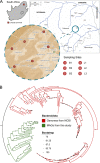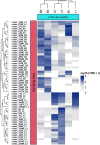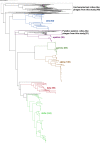CrAssphage May Be Viable Markers of Contamination in Pristine and Contaminated River Water
- PMID: 36744944
- PMCID: PMC9948693
- DOI: 10.1128/msystems.01282-22
CrAssphage May Be Viable Markers of Contamination in Pristine and Contaminated River Water
Abstract
Viruses are the most biologically abundant entities and may be ideal indicators of fecal pollutants in water. Anthropogenic activities have triggered drastic ecosystem changes in rivers, leading to substantial shifts in chemical and biological attributes. Here, we evaluate the viability of using the presence of crAssphage as indicators of fecal contamination in South African rivers. Shotgun analysis revealed diverse crAssphage viruses in these rivers, which are impacted by chemical and biological pollution. Overall, the diversity and relative abundances of these viruses was higher in contaminated sites compared to pristine locations. In contrast to fecal coliform counts, crAssphage sequences were detected in pristine rivers, supporting the assertion that the afore mentioned marker may be a more accurate indicator of fecal contamination. Our data demonstrate the presence of diverse putative hosts which includes members of the phyla Bacteroidota, Pseudomonadota, Verrucomicrobiota, and Bacillota. Phylogenetic analysis revealed novel subfamilies, suggesting that rivers potentially harbor distinct and uncharacterized clades of crAssphage. These data provide the first insights regarding the diversity, distribution, and functional roles of crAssphage in rivers. Taken together, the results support the potential application of crAssphage as viable markers for water quality monitoring. IMPORTANCE Rivers support substantial populations and provide important ecosystem services. Despite the application of fecal coliform tests and other markers, we lack rapid and reproducible approaches for determining fecal contamination in rivers. Waterborne viral outbreaks have been reported even after fecal indicator bacteria (FIB) were suggested to be absent or below regulated levels of coliforms. This indicates a need to develop and apply improved indicators of pollutants in aquatic ecosystems. Here, we evaluate the viability of crAssphage as indicators of fecal contamination in two South African rivers. We assess the abundance, distribution, and diversity of these viruses in sites that had been predicted pristine or contaminated by FIB analysis. We show that crAssphage are ideal and sensitive markers for fecal contamination and describe novel clades of crAss-like phages. Known crAss-like subfamilies were unrepresented in our data, suggesting that the diversity of these viruses may reflect geographic locality and dependence.
Keywords: bacteria; bacteriophages; crAssphage; faecal pollution; metagenome assembled genomes; phylogeny; viruses.
Figures




Similar articles
-
CrAssphage distribution analysis in an Amazonian river based on metagenomic sequencing data and georeferencing.Appl Environ Microbiol. 2025 May 21;91(5):e0147024. doi: 10.1128/aem.01470-24. Epub 2025 Apr 25. Appl Environ Microbiol. 2025. PMID: 40277368 Free PMC article.
-
Assessment of crAssphage as a human fecal source tracking marker in the lower Great Lakes.Sci Total Environ. 2024 Feb 20;912:168840. doi: 10.1016/j.scitotenv.2023.168840. Epub 2023 Nov 28. Sci Total Environ. 2024. PMID: 38036144
-
Applicability of F-specific bacteriophage subgroups, PMMoV and crAssphage as indicators of source specific fecal contamination and viral inactivation in rivers in Japan.PLoS One. 2023 Jul 14;18(7):e0288454. doi: 10.1371/journal.pone.0288454. eCollection 2023. PLoS One. 2023. PMID: 37450468 Free PMC article.
-
CrAssphage as an indicator of human-fecal contamination in water environment and virus reduction in wastewater treatment.Water Res. 2022 Aug 1;221:118827. doi: 10.1016/j.watres.2022.118827. Epub 2022 Jul 5. Water Res. 2022. PMID: 35820313 Review.
-
CrAss-Like Phages: From Discovery in Human Fecal Metagenome to Application as a Microbial Source Tracking Marker.Food Environ Virol. 2024 Jun;16(2):121-135. doi: 10.1007/s12560-024-09584-5. Epub 2024 Feb 27. Food Environ Virol. 2024. PMID: 38413544 Review.
Cited by
-
Evaluation of crAssphages as a potential marker of human viral contamination in environmental water and fresh leafy greens.Front Microbiol. 2024 Mar 28;15:1374568. doi: 10.3389/fmicb.2024.1374568. eCollection 2024. Front Microbiol. 2024. PMID: 38618485 Free PMC article.
-
CrAssphage distribution analysis in an Amazonian river based on metagenomic sequencing data and georeferencing.Appl Environ Microbiol. 2025 May 21;91(5):e0147024. doi: 10.1128/aem.01470-24. Epub 2025 Apr 25. Appl Environ Microbiol. 2025. PMID: 40277368 Free PMC article.
-
CrAssphage as a Human Enteric Viral Contamination Bioindicator in Marketed Bivalve Mollusks.Viruses. 2025 Jul 18;17(7):1012. doi: 10.3390/v17071012. Viruses. 2025. PMID: 40733628 Free PMC article.
-
Prevalence and Genetic Diversity of Cross-Assembly Phages in Wastewater Treatment Plants in Riyadh, Saudi Arabia.Microorganisms. 2023 Aug 27;11(9):2167. doi: 10.3390/microorganisms11092167. Microorganisms. 2023. PMID: 37764011 Free PMC article.
-
Tools and methodology to in silico phage discovery in freshwater environments.Front Microbiol. 2024 May 31;15:1390726. doi: 10.3389/fmicb.2024.1390726. eCollection 2024. Front Microbiol. 2024. PMID: 38881659 Free PMC article. Review.
References
-
- Magana-Arachchi DN, Wanigatunge RP. 2020. Ubiquitous waterborne pathogens, p 15–42. In Prasad MN, Grobelak A (ed), Waterborne pathogens detection and determination. Butterworth-Heinemann, Oxford. doi:10.1016/B978-0-12-818783-8.00002-5. - DOI
-
- Edokpayi JN, Odiyo JO, Durowoju OS. 2017. Impact of wastewater on surface water quality in developing countries: a case study of South Africa, p 401–416. In Tutu H (ed), Water quality. TechOpen, London.
-
- Bartram J, Fewtrell L. 2001. Water quality: guidelines, standards and health: assessment of risk and risk management for water-related infectious disease. IWA.
Publication types
MeSH terms
Associated data
LinkOut - more resources
Full Text Sources
